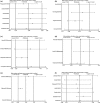Bacterial, viral, and fungal infection-related risk of Parkinson's disease: Meta-analysis of cohort and case-control studies
- PMID: 32017453
- PMCID: PMC7066372
- DOI: 10.1002/brb3.1549
Bacterial, viral, and fungal infection-related risk of Parkinson's disease: Meta-analysis of cohort and case-control studies
Abstract
Aims: Recent studies showed that patients with various bacterial, viral, and fungal infections might be at increased risk of Parkinson's disease (PD). However, the risk of PD in patients with each specific infection varied. This meta-analysis estimated the association between various infections and PD risk.
Methods: Literature published from January 1965 to October 2019 in PubMed and EMBASE databases was searched. Data were extracted and pooled using random/fixed effects model. Sensitivity analysis and meta-regression were also performed to analyze the source of heterogeneity. Publication bias was estimated by the trim and fill.
Results: Twenty-three out of 6,609 studies were included. Helicobacter pylori (HP; pooled OR = 1.653, 1.426-1.915, p < .001), hepatitis C virus (HCV; pooled OR = 1.195, 1.012-1.410, p = .035), Malassezia (pooled OR = 1.694, 1.367-2.100, p < .001), and pneumoniae (pooled OR = 1.595, 1.020-2.493, p = .041) infection were associated with increased PD risk. Influenza virus, herpes virus, hepatitis B virus, scarlet fever, mumps virus, chicken pox, pertussis, German measles, and measles were not associated with PD risk. After antiviral treatment against HCV reduced the risk of PD in patients with HCV infection (OR = 0.672, 0.571-0.791, p < .001). Significant heterogeneity exists among the included studies.
Conclusion: Patients with infection of HP, HCV, Malassezia, pneumoniae might be an increased risk of PD. Antiviral treatment of HCV could reduce the risk of PD.
Keywords: Helicobacter pylori; Malassezia; Parkinson disease; hepatitis C virus; infection; meta-analysis; pneumoniae; risk.
© 2020 The Authors. Brain and Behavior published by Wiley Periodicals, Inc.
Conflict of interest statement
All authors declare that they have no conflict of interest.
Figures







Similar articles
-
Impact of infection on risk of Parkinson's disease: a quantitative assessment of case-control and cohort studies.J Neurovirol. 2019 Apr;25(2):221-228. doi: 10.1007/s13365-018-0707-4. Epub 2019 Jan 10. J Neurovirol. 2019. PMID: 30632012
-
Meta-analysis: Association of Helicobacter pylori infection with Parkinson's diseases.Helicobacter. 2017 Oct;22(5). doi: 10.1111/hel.12398. Epub 2017 Jun 9. Helicobacter. 2017. PMID: 28598012 Review.
-
Association between hepatitis B virus/hepatitis C virus infection and primary hepatocellular carcinoma risk: A meta-analysis based on Chinese population.J Cancer Res Ther. 2016 Dec;12(Supplement):C284-C287. doi: 10.4103/0973-1482.200763. J Cancer Res Ther. 2016. PMID: 28230038
-
Infection and Risk of Parkinson's Disease.J Parkinsons Dis. 2021;11(1):31-43. doi: 10.3233/JPD-202279. J Parkinsons Dis. 2021. PMID: 33361610 Free PMC article. Review.
-
Association of Intestinal Disorders with Parkinson's Disease and Alzheimer's Disease: A Systematic Review and Meta-Analysis.ACS Chem Neurosci. 2020 Feb 5;11(3):395-405. doi: 10.1021/acschemneuro.9b00607. Epub 2020 Jan 8. ACS Chem Neurosci. 2020. PMID: 31876406
Cited by
-
Hepatitis C virus infection and Parkinson's disease: insights from a joint sex-stratified BioOptimatics meta-analysis.Sci Rep. 2024 Oct 1;14(1):22838. doi: 10.1038/s41598-024-73535-0. Sci Rep. 2024. PMID: 39354018 Free PMC article.
-
Non-Genetic Risk Factors for Parkinson's Disease: An Overview of 46 Systematic Reviews.J Parkinsons Dis. 2021;11(3):919-935. doi: 10.3233/JPD-202521. J Parkinsons Dis. 2021. PMID: 33814465 Free PMC article. Review.
-
Role of 14-3-3 protein family in the pathobiology of EBV in immortalized B cells and Alzheimer's disease.Front Mol Biosci. 2024 Jul 31;11:1353828. doi: 10.3389/fmolb.2024.1353828. eCollection 2024. Front Mol Biosci. 2024. PMID: 39144488 Free PMC article.
-
Infectious Microorganisms Seen as Etiologic Agents in Parkinson's Disease.Life (Basel). 2023 Mar 16;13(3):805. doi: 10.3390/life13030805. Life (Basel). 2023. PMID: 36983960 Free PMC article. Review.
-
Use of antiviral drugs and incidence of Parkinson's disease in Taiwan.PLoS One. 2024 May 7;19(5):e0302383. doi: 10.1371/journal.pone.0302383. eCollection 2024. PLoS One. 2024. PMID: 38713724 Free PMC article.
References
-
- Alam, Q. , Alam, M. Z. , Mushtaq, G. , Damanhouri, G. A. , Rasool, M. , Kamal, M. A. , & Haque, A. (2016). Inflammatory process in Parkinsons disease: Role for cytokines. Current Pharmaceutical Design, 22, 541–548. - PubMed
-
- Arsic Arsenijevic, V. S. , Milobratovic, D. , Barac, A. M. , Vekic, B. , Marinkovic, J. , & Kostic, V. S. (2014). A laboratory‐based study on patients with Parkinson's disease and seborrheic dermatitis: The presence and density of Malassezia yeasts, their different species and enzymes production. BMC Dermatology, 14, 5 10.1186/1471-5945-14-5 - DOI - PMC - PubMed
Publication types
MeSH terms
Grants and funding
LinkOut - more resources
Full Text Sources
Medical
Research Materials
Miscellaneous

